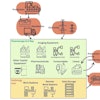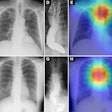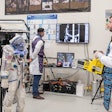CHICAGO - Radiology residents at two large teaching hospitals in Tennessee required twice as long as interventional radiologists to place central venous catheters (CVCs) under fluoroscopy guidance, effectively doubling the radiation dose to the patient, according to a study presented at the 2012 RSNA meeting.
Based on data collected over two years' time, residents took nearly a minute and a half to place CVCs, on average, compared to about 40 seconds for interventional radiologists. And surprisingly, the residents' extra seconds didn't decline in the later years of the residency, concluded researchers from Mid-South Imaging and Therapeutics (MSIT) and Baptist Memorial Health Care in Memphis.
"When we looked at fluoroscopy times for the two groups, the residents versus the staff cases, the average fluoroscopy time was 1.24 minutes for resident primary cases; the average staff time was almost exactly half of that at 0.63 minutes," said Dr. Richard Duszak Jr. from MSIT.
Issues relating to resident autonomy have been increasingly scrutinized over the past decade or more. At the same time, image-guided central venous catheterization has increased dramatically in recent years, and radiologists are the primary providers of central venous catheterization services. In teaching hospitals, radiology residents frequently serve as the primary operator, especially for lower-complexity procedures.
Nevertheless, the issue of radiation exposure for patients has received relatively little attention, Duszak said, and, unfortunately, minimization of radiation exposure from procedures performed by residents hasn't been a high priority in many programs.
"The purpose of this study was to evaluate differences in fluoroscopy time for interventional radiology procedures performed by residents versus staff radiologists, and we used temporary jugular venous catheter procedures as the model," Duszak said, noting that although fluoroscopy time is a crude metric for tracking radiation exposure from interventional procedures such as catheter placement, it's the simplest and easiest. Tracking temporary jugular CVC placement times also minimizes interservice and complexity variables, the authors explained in an abstract accompanying the study.
The study team used billing CPT codes to screen index services for the procedure, gathering reports and images from 1,067 temporary CVC services from two hospitals in 2008 and 2009. The researchers documented the insertion site, the catheter type (smaller triple lumen versus larger catheters for hemodialysis), resident and staff identification information, and fluoroscopy time for analysis.
In 128 of the procedures, 19 radiology residents were primary operators, performing from one to 29 cases each. In 409 cases, seven staff interventional radiologists were the primary operators, performing from one to 130 cases each.
Cases given to the residents and interventionalists were quite similar: The residents received 82% right- and 18% left-sided cases, compared with 79% right- and 21% left-sided cases for the staff interventionalists. The residents received 66% larger lumen and 36% smaller lumen cases, while staff received 63% larger lumen and 37% smaller lumen cases, Duszak said. In all, 537 complete records were available for analysis.
The mean fluoroscopy time for resident services (1.24 ± 1.39 minutes) was almost exactly twice as long as for staff services (0.63 ± 0.76 minutes, p < 0.001), he said. Fluoroscopy time varied little by postgraduate year for the residents, but it varied much more by supervising staff, ranging from 0.70 to 1.43 minutes. Mean fluoroscopy times for residents from PGY 2 to PGY 5 were 1.16, 1.45, 1.25, and 1.21 minutes, respectively -- with the longest time going to third-year residents.
"I have three residents, and I can only speculate as to the rationale, but for a lot of residents at this [PGY 3] level, it's a little less hands-on and they have a little more autonomy to work on the case on their own," Duszak said.
Also, "fluoroscopy time doesn't appear to decline with years of residency -- that may very well be related to the level of intensity of supervision, which is a confounding variable we were unable to extract from the data," he said.
Although only jugular CVC placement was studied for this pilot project, similar time discrepancies are likely to exist for other interventional radiology procedures, according to Duszak. "Moving forward, we're going to use natural language processing in our practice; we're going to be looking at things like dialysis, angioplasty -- things like that," he said.
"Radiology training programs should initiate programs to monitor and control fluoroscopy times during interventional procedures, so as to minimize dose to patients, trainees, and other staff," he said.



















